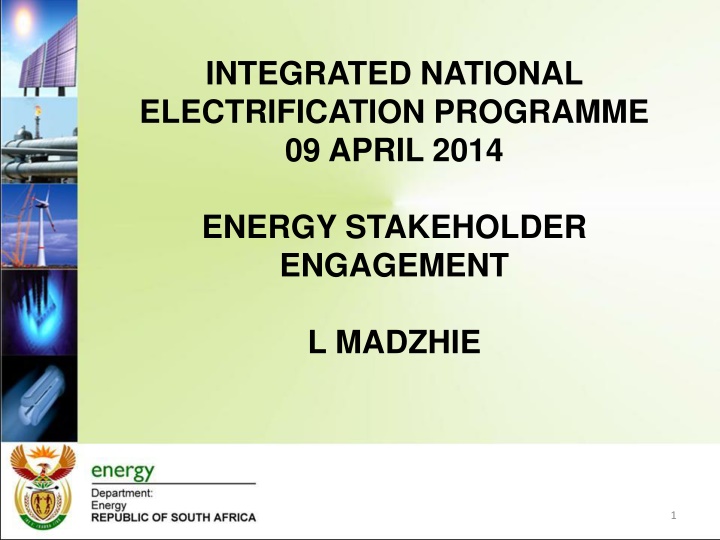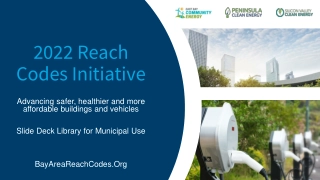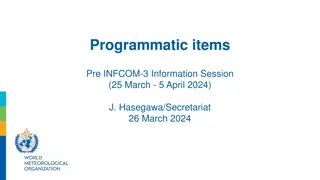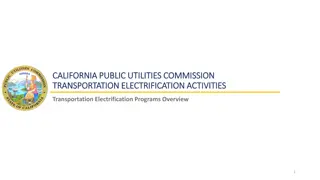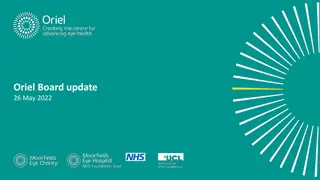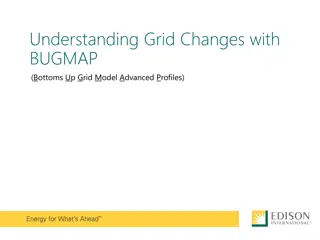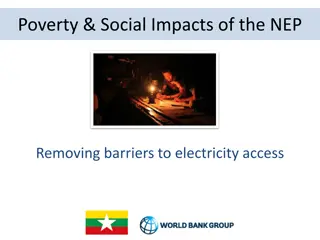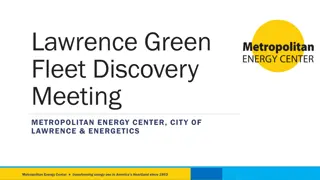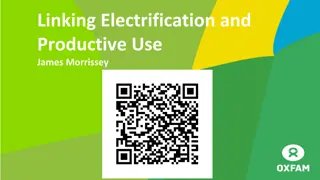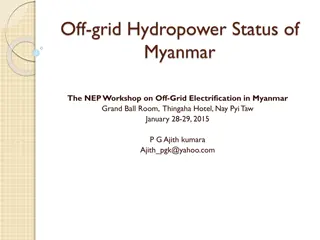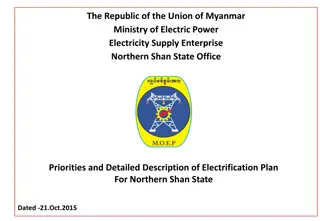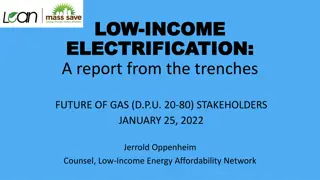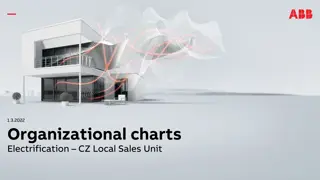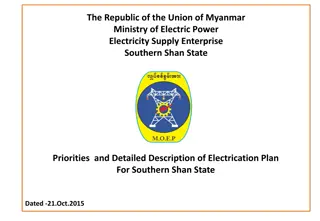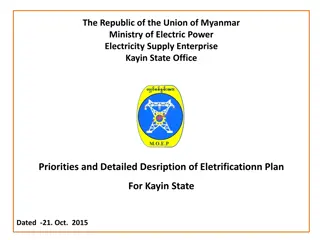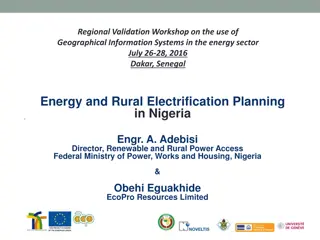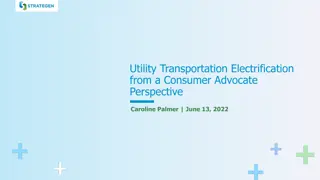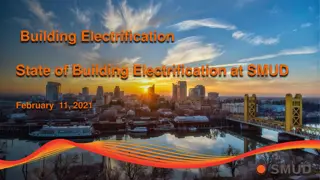Integrated National Electrification Programme Overview
The Integrated National Electrification Programme (INEP) in South Africa has made significant progress in connecting over 5.8 million households to the grid between 1994 and February 2014. Additionally, more than 75,000 households have benefited from non-grid electricity, mainly through solar home systems, in regions such as Eastern Cape, KwaZulu-Natal, and Limpopo. The program aims to achieve universal access to electricity, focusing on grid connections for 90% of households and high-quality non-grid solutions for the remaining percentage. The government's new Household Electrification Strategy, approved in 2013, outlines targets and plans to address backlogs and ensure efficient delivery processes.
Download Presentation

Please find below an Image/Link to download the presentation.
The content on the website is provided AS IS for your information and personal use only. It may not be sold, licensed, or shared on other websites without obtaining consent from the author.If you encounter any issues during the download, it is possible that the publisher has removed the file from their server.
You are allowed to download the files provided on this website for personal or commercial use, subject to the condition that they are used lawfully. All files are the property of their respective owners.
The content on the website is provided AS IS for your information and personal use only. It may not be sold, licensed, or shared on other websites without obtaining consent from the author.
E N D
Presentation Transcript
INTEGRATED NATIONAL ELECTRIFICATION PROGRAMME 09 APRIL 2014 ENERGY STAKEHOLDER ENGAGEMENT L MADZHIE 1
Electrification progress Over 5.8 million households were connected to the grid between 1994 and February 2014. Since the inception Electrification Programme in 2001/2 over 75 000 households benefitted and were connected to non-grid electricity by means of Solar (SHS).(Solar panels Energy), mostly in Eastern Cape, KwaZulu-Natal and Limpopo Non-grid electrification programmes will in future not only be implemented in concessionary areas, but in a limited basis in other areas in country. About 2600 direct jobs were created with the INEP programme. Extra 500 jobs were created in manufacturing and service support sectors created due to INEP programme. Electrified Houses: Municipalities & Eskom Province of Non-Grid Eastern Cape Free State Gauteng KwaZulu Natal Limpopo Mpumalanga Northern Cape North West Western Cape 1 048 562 Home System Renewable 365 813 687 284 966 499 1 021 947 562 522 135 068 677 371 397 612 Total 5 862 678 2
New Household Electrification Strategy The Cabinet Approved (26 June 2013) the implementing of the new Household Electrification Strategy based on the following focus areas: a) The defining of universal access as 97% of households, as full electrification is unlikely to be possible due to growth and delays in the process of formalising informal settlements; b) The electrification of about 90% of households through grid connection and the rest with high-quality non-grid solar home systemsor other possible technologies based on cost effective options in order to address current and future backlogs; c) The development of a master plan to increase efficiency in planning and the delivery process to ensure more connections, including a workshop on the Plan to which all members of Cabinet would be invited to; and The consideration of the proposed delivery targets, taking into consideration views with regard to- i. the proposed change to the delivery dates for universal access from 2014 to 2025 ii. the concern that the new proposed target of 250 000 households will contribute to the backlog with regard to the targets set by the Presidential Infrastructure Coordinating Commission (PICC); and iii. funding provided by the National Treasury to speed up connections 3
Additional non-grid aspects More municipalities can be assisted, but Councils are not taking resolutions wrt non-grid implementation; (1) agree that non-grid be installed in municipal area and (2) that a maintenance programme is been put in place. The Department will be conducting a non-grid electrification pilot in the informal settlements of the Nelson Mandela Metro Municipality. The intention is to provide total non-grid solutions in a form of lighting in the houses, as well as security lights in a form of solar street lights. The pilot will assist us in formulating policy in the future. A fuel cell generation pilot project is about to be installed in Moqhaka Municipality in Free State sponsored by Anglo Platinum. The fuel cell technology has never been tested for rural electrification and is a ground breaking project for the country to learn more about this sources of energy and whether it can be considered in the future for electrification purposes. 4
Using these rules, it is expected to deploy around 300,000 solar home systems and reach universal access for formal households in 2025 South Africa Provincial non-grid potential Thousand households Total connections 2013 2025 Million households 37 26 4 Non-grid 10% 16 0.3 84 11 28 90% 3.1 Grid 73 19 The highest potential for Non-grid is in KZN and Eastern Cape Time to electrify formal households 20251 1 Assumes existing INEP annual funding and DoHS contribution of R2,000 per household for new RDP houses (40,000 houses per annum); assumes total of 50,000 new formal households per year from DoHS formalization process 5
Way-forward Focus on management of roll out; maintenance challenges and further information on planning in relation to grid roll out. Need to transform the pilot non-grid programme to a sustainable programme in order to contribute to the target of universal access by 2025: a) Current concessioner/service providers programme to be transformed to a non-grid utility model; b) Need model that will attract long-term non-grid entities that can run programme in a sustainable manner; c) Based on an national master plan to determine grid and non-grid areas; d) Roll-out and maintenance of systems and e) No only rural areas, but also to address backlogs in informal urbanized areas. 6
Way-forward Implementation of Master Plan INEP need to be more involved in projects undertaken by municipalities to ensure they deliver on targets set. Creating of the steering committees in the provinces with assistance by MISA to assist the non performing municipalities The Department should annually revise the cost per connection subsidy to keep up with price increases of electrification materials Municipalities should fast track procurement processes and Council resolutions to enhance the pace of electrification within their area. Giving municipalities R1,5mil each for the pre engineering 7
